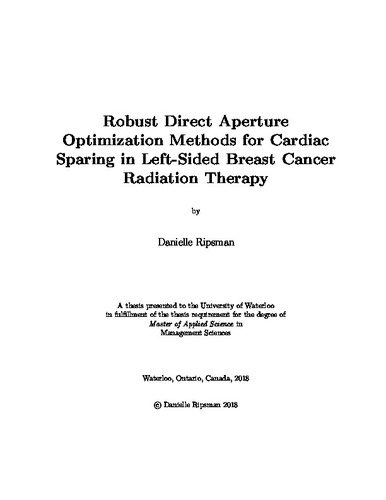| dc.description.abstract | Designing conformal and equipment-compatible radiation therapy plans is essential for ensuring high-quality treatment outcomes for cancer patients. Intensity modulated radiation therapy (IMRT) is a commonly-used method of radiation delivery for cancer patients, wherein beams of radiation are individually contoured to cover a patient’s tumour cells while avoiding healthy cells and organs. In IMRT for left-sided breast cancer, the goal is to irradiate all cells in the breast tissue while avoiding the neighbouring, and extremely radiation-sensitive, heart cells. To add to the complexity of this treatment, the entire dose must be delivered while the patient is breathing, causing the location of the heart and target organs to move and deform unpredictably.
The search for a plan that is of the highest quality for a specified set of parameters is called treatment plan optimization. One method of treatment plan optimization that provides an optimal radiation distribution, even under the worst-case realization of a patient’s motion uncertainty, uses a framework called robust optimization. A drawback of using this robust optimization framework, however, is that it does not immediately output physically deliverable IMRT plans. Rather, a subsequent, non-trivial post-processing phase must be applied to the output intensity distributions in order to generate an equipment-compatible plan; a process which can substantially degrade the treatment quality.
In this thesis, a holistic approach that combines enforcement of delivery constraints with robust optimization is introduced. The process for creating deliverable plans is called direct aperture optimization (DAO), and the combined model is called robust DAO (RDAO). Novel modelling strategies for integrating the DAO requirements into a robust framework are presented, leading to a large-scale difficult-to-solve mixed integer programming problem. To contend with the complexity of the problem, additional modelling approaches are suggested for improving solution efficiency. These approaches include a hybrid heuristic-optimization technique, which provides good quality, but non-optimal treatment plans. Clinicians may use the output of this hybrid technique as is, or apply it as a warm start for the RDAO model.
The models are implemented in C++ and CPLEX and results are presented, first using a one-dimensional phantom, and then a three-dimensional clinical patient dataset. While the full RDAO model is quite time-consuming to run, high-quality plans are ultimately produced. These plans are both clinically deliverable and mitigate the risk of underdosing a patient’s cancerous cells under motion uncertainty, demonstrating their value over plans that did not account for motion uncertainty. | en |

